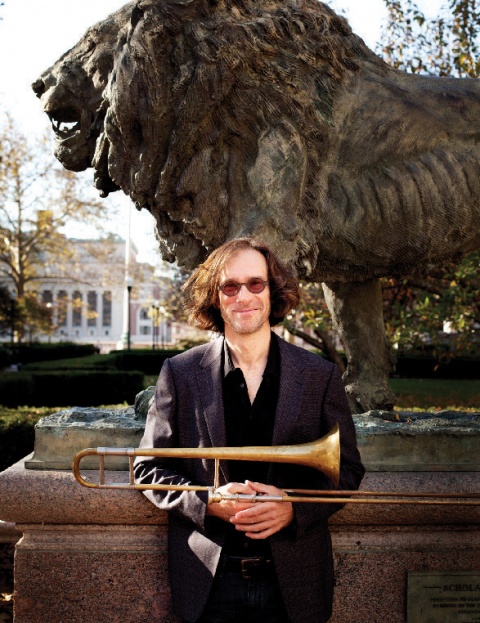Columbia College | Columbia University in the City of New York
The Essentials: Chris Washburne GSAS’99
JÖRG MEYER
Associate Professor of Music Chris Washburne GSAS’99 is an acclaimed trombonist whose interests and versatility extend to jazz, classical, rock and Latin music. His seven-member band SYOTOS is hailed for its innovations in Latin jazz, and Washburne has played with musicians as diverse as Tito Puente, Arturo Sandoval, David Byrne, Björk and Justin Timberlake. On the faculty at Columbia since 2001, he performs up to five nights a week during the school year in addition to teaching, his directorship of the University’s Louis Armstrong Jazz Performance Program and other activities. But he took time out one afternoon in September — on the eve of a performance at no lesser a venue than Carnegie Hall — to talk about the varied beats of his life and career.
He grew up on a farm in Bath, Ohio, a small town south of Cleveland.
His first gig was in high school, as the trombonist in a Led Zeppelin cover band.
He became interested in music as a career through his stepfather, an amateur jazz drummer. “He always had jazz playing in his car and took our family to local clubs. We saw the Count Basie Band, Lionel Hampton’s band, some really famous musicians.”
He earned a bachelor’s of music in classical trombone performance from University of Wisconsin - Madison and a master’s in third stream studies from the New England Conservatory of Music. His Ph.D. is in ethnomusicology: “using music as a lens into the study of culture — combining the fields of anthropology and musicology.”
He led the charge to add jazz to the Core in Music Humanities classes, which happened in 2003. “I always thought it was strange that we would study Gershwin and Stravinsky, two musicians who were much influenced by jazz and who influenced jazz greatly — but we weren’t talking about Duke Ellington or Louis Armstrong. Having even a small unit of jazz in the Core enables students to connect the music that they listen to much more easily to classical music traditions and to a variety of different societal forces.”
His class “Salsa, Soca and Reggae: Popular Musics of the Caribbean,” part of the Global Core, draws upward of 400 students. “What I really want is for students to discover themselves in the sounds that we’re studying, even if those sounds are coming from places that are far from where they are from. I push students to go beyond the classroom walls, to really come up close to, and have interpersonal relationships with, the music or the communities that we’re studying.”
He founded the Louis Armstrong Jazz Performance Program, which offers jazz instruction and performance opportunities through the Music Department, because he thought that “having a university that abuts one of the most important neighborhoods in jazz history — Harlem — and not having an official jazz program was ridiculous.” From eight students the first year, in 2002, the program has grown to roughly 130 students across 17 ensembles.
He recently spent a year making music with inmates at Sing-Sing — part of a new project of his that looks at how jazz and the principles and processes behind the music can be applied to different fields. “I was teaching the inmates how to write music, how to improvise within a musical setting, and then trying to connect those musical experiences to their own life experiences — to processes of transcendence, of catharsis, of redemption, of healing and reform — and seeing where that goes. It was one of the most amazing musical experiences of my life.”
SYOTOS released its sixth record, Low Ridin’, in April. “I decided to do Afro-Latin versions of songs that were important to me in my youth,” he says. Among the artists covered are Lou Reed, Jimi Hendrix, the Doors and, yes, Led Zeppelin.
SYOTOS stands for See You on the Other Side, a phrase that came to him while performing what he thought might be his last concert, in 1992. Days before, Washburne had been “out of the blue” diagnosed with a virulent skin cancer and given low chances of survival. But after surgery that removed the nerve and muscles from half his face, he recovered and has been cancer-free since. It took him two years to fully regain his musical chops.
He still has his first trombone. A neighbor gave it to him when he started learning because his family couldn’t afford one. “It had been in the attic, this tarnished thing, covered in dirt and dust — horrible looking. I came home and cried. But my mother said I didn’t have a choice, if I wanted to play, I had to play this.” Though he bought a new trombone for college, there came a day when he had to use the old one for practice. His band conductor, who was an antique instrument collector, “took one look and offered me thousands of dollars for it. I said,‘Uhh, why?’ and he explained what a rare and great instrument it was. Suddenly my attitude changed drastically. It’s from 1938. I still play it sometimes.”
Issue Contents
Published three times a year by Columbia College for alumni, students, faculty, parents and friends.
Columbia Alumni Center
622 W. 113th St., MC 4530, 6th Fl.
New York, NY 10025
212-851-7852
cct@columbia.edu
Columbia Alumni Center
622 W. 113th St., MC 4530, 4th Fl.
New York, NY 10025
212-851-7488
ccalumni@columbia.edu

